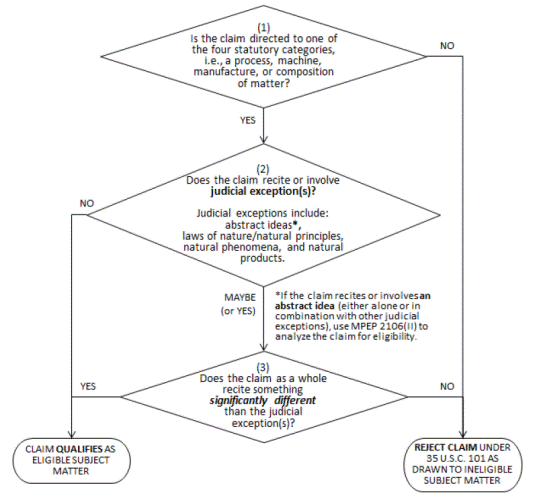
Rule Review
“Natural” Exceptions to Subject Matter Eligibility: New USPTO Guidance
As the law evolves concerning exceptions to patentable subject matter under 35 U.S.C. § 101, so does the guidance applicable to patent examiners. Accordingly, based on the Supreme Court’s recent pronouncements of the judicial exceptions to patent eligibility for laws of nature, natural principles, natural phenomena, and natural products, the U.S. Patent and Trademark Office (USPTO) issued Guidance For Determining Subject Matter Eligibility Of Claims Reciting Or Involving Laws of Nature, Natural Phenomena, & Natural Products “ (Guidance”) (http://www.uspto.gov/patents/law/exam/myriad-mayo_guidance.pdf), on March 4, 2014. The Guidance will impact the work of both examiners and practitioners.
The Guidance accounts for the Supreme Court’s decisions in Ass’n. for Molecular Pathology v. Myriad Genetics, Inc., 569 U.S. __, 133 S. Ct. 2107 (2013), and Mayo Collaborative Services v. Prometheus Laboratories, Inc., 566 U.S. __, 132 S. Ct. 1289 (2012). While the Guidance applies to all claim types (i.e., machine, composition, manufacture, and process claims), it only applies to claims reciting or involving laws of nature, natural phenomena, and natural products, which the Guidance recognizes as “judicial exceptions” to patentability. Guidance at 1-2. The Guidance does not, for example, apply to the “abstract idea” exception to patent eligibility. Id. at 1. The Guidance supersedes the prior June 13, 2013, USPTO memorandum titled “Supreme Court Decision in Association for Molecular Pathology v. Myriad Genetics, Inc.”
The Guidance is comprised of four parts. Part I focuses on the overall process for determining the eligibility of inventions that claim or involve natural laws, phenomena, and products. To illustrate the process, a flowchart is provided representing a process of asking whether an invention: (1) is directed to one of the four statutory categories of patentability (i.e., a process, machine, manufacture, or composition of matter); (2) claims or involves a judicial exception to such categories of subject matter (i.e., an abstract idea, law of nature, natural principle, natural phenomenon, or natural product); and (3) recites, as a whole, something “significantly different” than such judicial exceptions. The flowchart is reproduced below:

Id. at 2.
Part II of the Guidance focuses on how examiners should judge whether an invention is “significantly different” than a judicial exception to patent eligibility, i.e., the third step in the overall process of Part I. According to the Guidance, a “significant difference” between a claimed invention and a judicial exception to patent eligibility (i.e., a natural product, law of nature, or natural phenomenon) may be shown where a claim includes elements in addition to the judicial exception that “practically apply” the judicial exception in a significant way, or when the claim includes features or steps demonstrating that the claimed subject matter is markedly different from what exists in nature. Id. at 3-4. The Guidance further provides a list of factors that examiners should consider in a balancing test to determine whether a claim represents a “significant difference” vis-à-vis a judicial exception to patent eligibility. Id. at 4-5.
Part III of the Guidance provides several examples of claims to illustrate how the process and analysis of Parts I and II should be applied. In a first example, a claim directed to a “stable energy-generating plasmid, which provides a hydrocarbon degradative pathway,” is deemed patent ineligible based on the above factors, but a claim directed to a “bacterium from the genus Pseudomonas containing therein at least two stable energy-generating plasmids, each of said plasmids providing a separate hydrocarbon degradative pathway,” is considered patent eligible based on Parts I and II of the Guidance. Id. at 5-6. A further example directed to a “fountain-style firework” is found to be patent eligible under the framework identified in Parts I and II of the Guidance. Id. at 9-10. Various other examples are provided and analyzed as well.
Finally, Part IV of the Guidance provides a “form paragraph” for examiners to use when rejecting a claim that recites or involves a natural law, principle, phenomenon, or product. Id. at 18. The form paragraph states: “[T]he claimed invention is not directed to patent eligible subject matter. Based upon an analysis with respect to the claim as a whole, claim(s) do not recite something significantly different than a judicial exception. The rationale for this determination is explained below . . . .” Id. (examiner notes omitted).
Because the Guidance took effect within the USPTO immediately upon its issuance on March 4, 2014, it has started, and will continue, to affect examination of inventions directed to natural laws, principles, phenomena, and products. Practitioners in a variety of fields, including chemical, materials science, pharmaceutical, and biological inventions in particular, should give special attention to the Guidance when formulating new claims and preparing claim amendments. While the changes and clarifications within the Guidance are important to note, what the Guidance leaves unchanged is equally important. In particular, the Guidance is explicit in stating that “[t]here is no change to examination of claims reciting an abstract idea, which should continue to be analyzed for subject matter eligibility using the existing guidance in MPEP § 2106(II).” Thus, while the Guidance provides additional illumination for examiners and practitioners with respect to all types of claims reciting or involving natural laws, principles, phenomena, and products, it leaves untouched examination practices for other areas of compliance with 35 U.S.C. § 101, as well as other statutory requirements for patentability. For more information on the Guidance and how the USPTO intends for it to be applied, the USPTO issued a presentation dated March 19, 2014, which is available at the USPTO’s website.